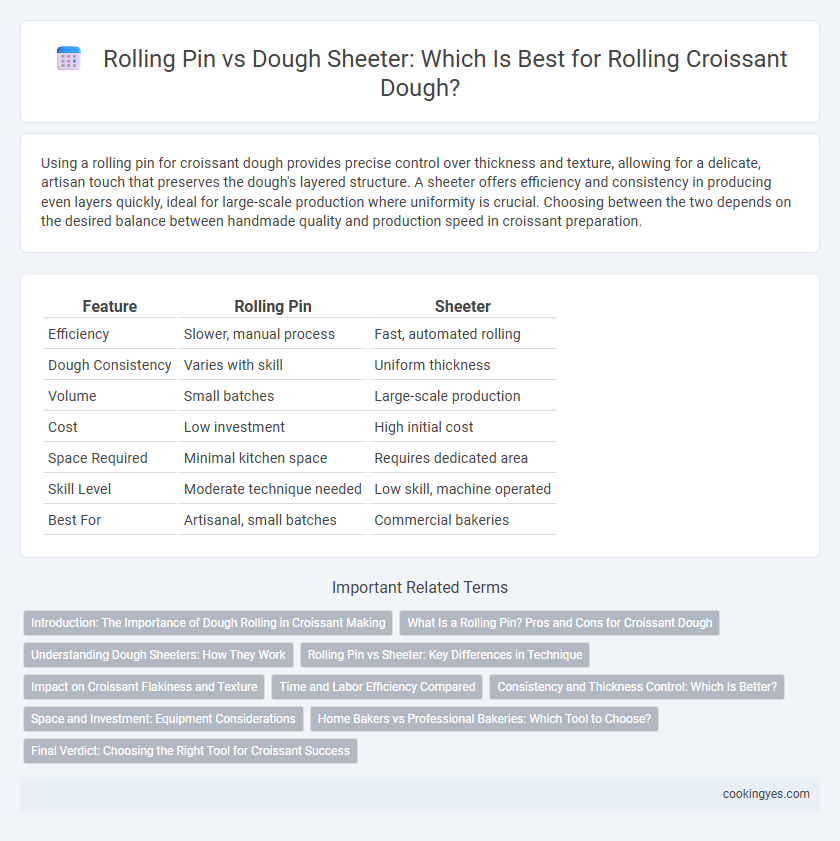Using a rolling pin for croissant dough provides precise control over thickness and texture, allowing for a delicate, artisan touch that preserves the dough's layered structure. A sheeter offers efficiency and consistency in producing even layers quickly, ideal for large-scale production where uniformity is crucial. Choosing between the two depends on the desired balance between handmade quality and production speed in croissant preparation.
Table of Comparison
| Feature | Rolling Pin | Sheeter |
|---|---|---|
| Efficiency | Slower, manual process | Fast, automated rolling |
| Dough Consistency | Varies with skill | Uniform thickness |
| Volume | Small batches | Large-scale production |
| Cost | Low investment | High initial cost |
| Space Required | Minimal kitchen space | Requires dedicated area |
| Skill Level | Moderate technique needed | Low skill, machine operated |
| Best For | Artisanal, small batches | Commercial bakeries |
Introduction: The Importance of Dough Rolling in Croissant Making
Dough rolling plays a critical role in croissant making by creating the layered, flaky texture that defines the pastry. Using a rolling pin allows for precise control and tactile feedback, essential for maintaining even dough thickness and incorporating butter layers. In contrast, a sheeter offers efficiency and consistency, especially beneficial in high-volume production, but may lack the nuanced pressure adjustments achievable by hand rolling.
What Is a Rolling Pin? Pros and Cons for Croissant Dough
A rolling pin is a cylindrical kitchen tool used to manually flatten and shape croissant dough, providing precise control over thickness and texture. It allows for delicate handling essential for maintaining the multiple buttery layers but can be time-consuming and physically demanding for large batches. While it offers versatility for small-scale baking and artisanal croissants, inconsistency in pressure may lead to uneven lamination compared to machine sheeters.
Understanding Dough Sheeters: How They Work
Dough sheeters automate the rolling process by passing croissant dough through adjustable rollers, ensuring uniform thickness and consistent texture essential for flaky layers. Unlike manual rolling pins, sheeters provide precise pressure control, reducing dough overworking and saving significant preparation time in professional bakeries. This technology enhances dough elasticity and lamination, crucial for achieving the ideal croissant rise and delicate crumb structure.
Rolling Pin vs Sheeter: Key Differences in Technique
Rolling pins require manual pressure and skill to evenly thin croissant dough, promoting tactile control over dough thickness and layering. Sheeters use mechanical rollers to produce consistent, uniform sheets quickly, ideal for high-volume production without compromising dough integrity. The choice depends on the desired precision, dough handling, and production scale in croissant preparation.
Impact on Croissant Flakiness and Texture
Using a rolling pin for croissant dough allows precise control over thickness and pressure, preserving delicate layers essential for optimal flakiness and a tender, airy texture. In contrast, a sheeter can provide consistent, even rolls but risks compressing the dough too much, potentially reducing the distinct laminated structure that defines traditional croissants. Professional bakers often prefer a rolling pin to maintain the dough's integrity and achieve the signature flaky, layered crumb characteristic of high-quality croissants.
Time and Labor Efficiency Compared
A rolling pin allows for precise control and flexibility when shaping croissant dough but requires considerable time and manual effort, making it less efficient for large batches. A sheeter automates the dough rolling process, significantly reducing labor and time by producing uniform layers quickly, ideal for commercial-scale production. Choosing between tools depends on balancing artisanal quality with the need for speed and efficiency in the baking workflow.
Consistency and Thickness Control: Which Is Better?
A sheeter provides precise consistency and thickness control when rolling croissant dough, ensuring uniform layers essential for optimal lamination and flaky texture. Rolling pins rely heavily on manual skill, often resulting in variable dough thickness and uneven layering. For professional bakers seeking repeatable, consistent croissant quality, sheeters outperform rolling pins in maintaining exact dough dimensions.
Space and Investment: Equipment Considerations
Choosing between a rolling pin and a dough sheeter for croissant preparation significantly impacts space utilization and financial investment. Rolling pins require minimal storage space and have a low upfront cost, ideal for small kitchens or artisanal bakeries. In contrast, dough sheeters demand substantial floor space and a higher initial investment but enhance production efficiency and ensure uniform dough thickness for large-scale operations.
Home Bakers vs Professional Bakeries: Which Tool to Choose?
Home bakers often prefer a rolling pin for croissant dough due to its accessibility, control, and cost-effectiveness, allowing precise thickness adjustments critical for flaky layers. Professional bakeries typically utilize dough sheeters, which offer consistent, rapid, and uniform rolling essential for producing large quantities of croissants efficiently. Choosing between a rolling pin and a sheeter depends on production scale, with rolling pins best suited for artisanal, small-batch baking and sheeters optimized for high-volume, commercial operations.
Final Verdict: Choosing the Right Tool for Croissant Success
When deciding between a rolling pin and a sheeter for croissant dough, precision and texture are key factors influencing the final product. A rolling pin offers artisanal control and gradual layering essential for flaky croissants, while a sheeter ensures uniform thickness and speed, ideal for high-volume production. Selecting the right tool depends on balancing craftsmanship with efficiency to achieve consistently laminated, buttery layers characteristic of perfect croissants.
Rolling Pin vs Sheeter for Croissant Dough Rolling Infographic

 cookingyes.com
cookingyes.com